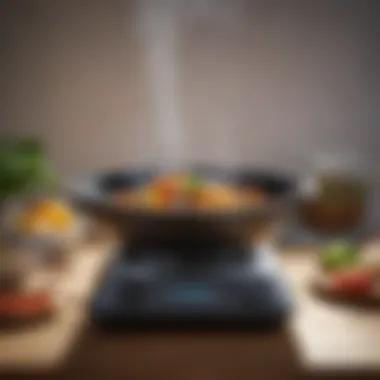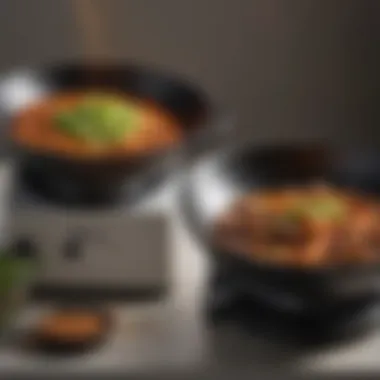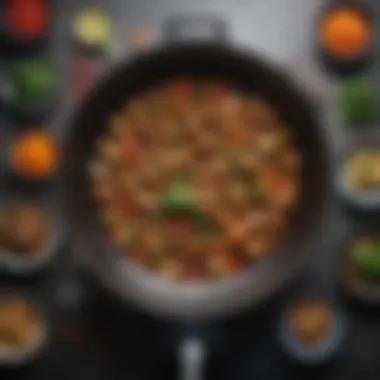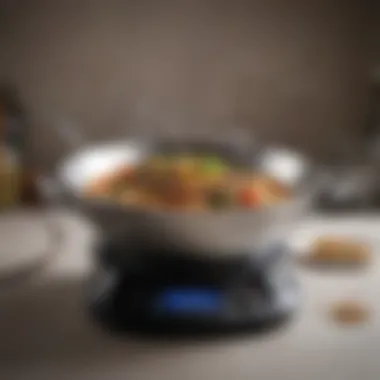The Electric Wok Pan: A Comprehensive Exploration


Intro
The electric wok pan represents a modern evolution in home cooking. Designed with efficiency in mind, it merges traditional cooking techniques with technological advancements. This device enhances the cooking experience, allowing users to prepare various dishes with precision and ease. As we explore this kitchen marvel, a detailed understanding of its features, benefits, and practical uses will enrich your culinary journey.
Recipe Overview
Dish Description
The electric wok pan is versatile and can be used to prepare an array of dishes. Dishes like stir-fries, curries, and even steamed vegetables can be effortlessly cooked in this device. Its design allows for even heat distribution, promoting consistent cooking results.
Cuisine Type
The electric wok is particularly suited for Asian cuisines. However, its adaptability invites experimentation with various culinary traditions around the world. Whether one is making a classic Chinese stir-fry or a Thai curry, the electric wok can handle it all with finesse.
Ingredients List
Detailed Ingredients
Common ingredients for dishes made in the electric wok include:
- Fresh vegetables (bell peppers, broccoli, carrots)
- Proteins (chicken, shrimp, tofu)
- Sauces (soy sauce, oyster sauce)
- Spices (ginger, garlic, chili)
- Starch (rice, noodles)
Substitutions and Variations
Variations can cater to different dietary preferences. For instance:
- Instead of chicken, use chickpeas for a vegetarian option.
- Substitute soy sauce with tamari for a gluten-free alternative.
- Add seasonal vegetables to enhance the flavor and nutritional value.
"The electric wok pan is not just a cooking appliance; it is a gateway to endless culinary possibilities."
Benefits of the Electric Wok
This cooking tool offers distinct advantages over traditional pans:
- Temperature Control: Electric models allow precise heat settings, ideal for various cooking methods.
- Energy Efficiency: It heats up quickly, reducing overall cooking time.
- Ease of Cleaning: Many electric woks come with non-stick surfaces that simplify the cleaning process.
Care and Maintenance
Proper care extends the lifespan of your electric wok. Some tips include:
- Always follow the manufacturer’s instructions on cleaning.
- Use non-abrasive materials to avoid scratching the surface.
- Store it in a dry place to prevent moisture accumulation.
Safety Considerations
Safety is crucial when using an electric wok:
- Always monitor the cooking process to prevent overheating.
- Ensure the plug and socket are in good condition to avoid electrical hazards.
- Keep flammable materials way from the wok during use.
Preamble to Electric Wok Pans
The electric wok pan represents a significant advancement in home cooking technology. This device provides distinct advantages over traditional stovetop woks, making it essential to explore its key features and benefits. In modern kitchens, the electric wok pan serves various purposes, from stir-frying to steaming, enhancing the versatility of meal preparation. Its convenience and efficiency have made it a favored choice among both novice and experienced cooks.
Understanding the Concept of Electric Cooking
Electric cooking encompasses using electricity as the primary heat source for food preparation. Unlike gas or charcoal, electric cooking offers more consistent temperature control. This is particularly beneficial for dishes requiring precise cooking times and temperatures. Electric woks are designed with specific features that cater to this cooking method. Many have built-in thermostats that help maintain an even cooking temperature. This reliability allows cooks to focus more on the culinary process and less on the equipment.
Historical Evolution of Woks
The wok has an extensive history, originating in China thousands of years ago. Traditional woks are typically made from carbon steel or cast iron and are utilized over high flame heat. This makes them excellent for quick cooking techniques. Over the centuries, the design and materials of woks have evolved.
With the advent of electric cooking, the concept of the wok adapted to include electric models. These electric woks maintain the essential characteristics of traditional woks but add features like adjustable heat settings and non-stick surfaces. This evolution reflects changing cooking preferences and technological advancements. Today, electric woks cater to the diverse culinary needs of various cultures globally.


Unique Features of Electric Wok Pans
Electric wok pans are increasingly popular. Their unique features distinguish them from traditional woks. Understanding these features helps food enthusiasts utilize them fully in their culinary practices. Here, we explore three primary aspects that set electric wok pans apart from conventional cooking tools.
Temperature Control Mechanisms
Temperature control is a hallmark of electric wok pans. Unlike traditional stovetop woks, which rely on flame intensity, electric models offer precision. Most feature adjustable settings that allow users to select the exact temperature needed for specific cooking tasks.
This feature is vital for various cooking techniques. For instance, stir-frying requires high heat to cook quickly, while simmering demands lower temperatures. Many electric woks have a built-in thermostat. This element helps maintain consistent heat, preventing overcooking or burning food. Such controls make it easier to cook delicate ingredients, such as seafood or vegetables, ensuring optimal texture and flavor.
Material Composition
Material composition affects the performance and durability of electric woks. Generally, they are made from a blend of metals and coatings. Most are crafted from aluminum for its excellent heat conductivity. This metal ensures that heat spreads evenly across the surface, reducing hotspots.
In addition to metal, many electric woks include special coatings. These can range from traditional non-stick to advanced ceramic materials. Non-stick coatings minimize the need for cooking oils, promoting health-conscious cooking. It also simplifies cleanup, an essential factor in busy kitchens. However, the longevity of such coatings varies, depending on their quality and how well the pan is maintained.
Non-Stick Coating Benefits
Non-stick coatings offer several benefits that enhance the cooking experience with electric woks. Firstly, they allow for easier food release. When stir-frying meats or vegetables, food does not stick, leading to less frustration during cooking. This feature encourages home cooks to explore various recipes without the worry of food remnants on the surface.
Secondly, the presence of a non-stick layer often reduces the amount of oil or fat needed. This attribute suits those pursuing healthier diets while still enjoying flavorful meals. Moreover, cleaning becomes far more manageable, as residues wash away effortlessly. In sum, the non-stick coating is a valuable feature that promotes efficiency and enjoyment in cooking.
It is essential to follow proper maintenance practices for non-stick surfaces to prolong their lifespan. Avoid using metal utensils that can scratch and damage the coating, leading to wear over time.
Advantages of Using Electric Wok Pans
Electric wok pans have become increasingly popular among home cooks due to their numerous benefits. In this section, we will explore the key advantages of using electric woks, focusing on energy efficiency, versatility in cooking techniques, and safety features.
Energy Efficiency Compared to Traditional Cooking Methods
One of the significant benefits of electric wok pans is their energy efficiency. Traditional cooking methods, especially those involving gas stoves, often lead to higher energy consumption. Electric woks, however, typically reach desired temperatures more quickly and maintain heat effectively. This characteristic not only reduces cooking time but also lowers energy costs.
Electric woks use a direct heat source, heating the cooking surface uniformly. This method prevents hotspots and ensures consistent cooking results. Additionally, the ability to adjust temperatures swiftly allows for quick temperature transitions, which can be crucial when preparing different dishes.
"Using an electric wok can substantially reduce your energy consumption, making your cooking both efficient and economical."
Versatility in Cooking Techniques
Another advantage of electric wok pans is their versatility. With one appliance, users can prepare a wide array of dishes. Stir-frying, steaming, and sautéing are some of the classic techniques that electric woks excel in. They are designed to accommodate different cooking styles, making them suitable for various cuisines.
Additionally, electric woks enable home cooks to experiment with fusion recipes. They can easily blend the flavors and techniques from different cultures, such as Thai stir-fries or Italian sautéed vegetables.
Some popular cooking techniques include:
- Stir-Frying: Quick cooking using high heat keeps the vegetables crisp.
- Steaming: The raised design of many electric woks allows for steaming without extra equipment.
- Sautéing: Provides a quick method to cook meats and vegetables, retaining their flavors.
This versatility means that the electric wok can replace multiple kitchen appliances, simplifying meal prep.
Safety Features in Electric Woks
Safety is a crucial consideration when using any cooking appliance. Electric wok pans come equipped with several safety features that enhance the user experience.
Most modern electric woks have automatic shut-off capabilities. This feature prevents overheating and potential accidents. Temperature control settings also help users maintain optimal cooking conditions, reducing risks.
Many electric woks are designed with cool-touch handles and anti-slip feet, ensuring safe handling and stability during use. By prioritizing safety, manufacturers allow users to focus on cooking without constant worry about potential hazards.
In summary, the advantages of electric wok pans make them an appealing option for both novice and experienced cooks.
\nWhat separates electric woks from traditional cooking methods is their energy efficiency, versatility, and safety features. Each of these elements contributes to a more enjoyable and efficient cooking experience.
Operational Guidelines for Electric Wok Pans


Understanding how to properly use electric wok pans is essential for maximizing their potential in the kitchen. This section provides operational guidelines that outline various considerations and benefits. Knowing these guidelines can lead to improved cooking efficiency, enhanced safety, and better overall culinary results.
Getting Started: Initial Setup
When you first acquire an electric wok, following the initial setup steps is crucial. Begin by finding a suitable working space. A flat, stable surface is ideal. Make sure to plug the wok into a power outlet that meets the required voltage.
Next, familiarize yourself with the control panel. Electric woks typically feature temperature settings and cooking modes. Always refer to the manufacturer's instructions for the specific model you own. Before using it for the first time, clean the cooking surface with warm soapy water to remove any factory residue. This step is often overlooked, yet essential for food safety.
Cooking Techniques: Stir-Frying, Steaming, and More
Electric woks offer a variety of cooking techniques that can elevate your culinary game. Stir-frying is perhaps the most popular method, beneficial for quick cooking. The high, even heat of the electric wok allows ingredients to cook rapidly without losing their crunch.
Another technique is steaming, which can be accomplished using the appropriate accessories. Many electric woks come with a steaming tray. This method is particularly useful for cooking vegetables, fish, or dumplings, retaining flavor and nutrients.
Lastly, you can also use electric woks for simmering and braising. This versatility gives users the option to create an array of dishes, from traditional Asian meals to modern fusion recipes. Experimenting with these techniques can enhance your cooking repertoire.
Choosing Compatible Ingredients
Selecting the right ingredients is vital for successful cooking in an electric wok. Not all ingredients respond well to the high heat and fast cooking style of woks. Generally, fresh, seasonal vegetables work best. Crisp vegetables like bell peppers, broccoli, and snap peas maintain their texture and color when stir-fried.
For proteins, lean cuts of meat such as chicken and beef slices are preferable. These cook quickly and evenly in an electric wok. Tofu is also an excellent choice for vegetarian dishes, absorbing flavors effectively.
Additionally, consider using thinly sliced ingredients. These cut down on cooking time, ensuring even heat distribution. Here is a quick list of compatible ingredients:
- Fresh vegetables: bell peppers, carrots, asparagus
- Proteins: chicken, beef, shrimp, tofu
- Flavor enhancers: garlic, ginger, and soy sauce
By following these operational guidelines, you can utilize your electric wok pan to its fullest potential, enjoying a range of cooking methods and flavors.
Recipes Perfect for Electric Wok Cooking
When considering the advantages of electric wok pans, the types of recipes that can be created play a crucial role. Electric woks offer a versatile cooking space that embraces various culinary styles. This exploration into recipes will showcase the electric wok's adaptability.
The right recipes maximize the potential of the electric wok, ensuring optimal use of its features like consistent heating, rapid temperature adjustments, and spacious cooking capacity. Selecting meals that suit this equipment can enhance flavor and cooking efficiency.
Traditional Asian Dishes
Traditional Asian dishes are a perfect match for electric wok pans. The design of the wok, deep and spacious, allows for easy tossing and stirring, essential for authentic Asian cooking methods. For instance, stir-frying is a common technique that benefits significantly from the high heat capacity of electric woks. Dishes such as:
- Chow Mein: This stir-fried noodle dish achieves its texture and flavor when prepared quickly at high temperatures. The electric wok provides the necessary heat to caramelize ingredients, lending depth to the dish.
- Fried Rice: This dish can be easily prepared in an electric wok, allowing for even distribution of heat. Quickly tossing rice with vegetables and proteins ensures that each grain is coated in flavor, which is often harder to achieve in traditional pans.
- Kung Pao Chicken: A classic stir-fry that requires precise temperature control to achieve the right balance between heat and flavor. The electric wok facilitates this by providing consistent and adjustable heat levels.
Overall, employing these recipes within the electric wok demonstrates its capability to recreate traditional flavors while simplifying the cooking process.
Innovative Fusion Recipes
The fusion of diverse culinary traditions into innovative recipes expands the creative potential of electric wok cooking. These recipes integrate flavors and techniques from various cuisines, resulting in unique and exciting dishes. Consider the following:
- Mexican Stir-Fry: Combining classic Mexican ingredients such as bell peppers, corn, and spices with traditional stir-fry techniques allows for a vibrant dish that celebrates both culinary worlds. The electric wok's large surface area is ideal for searing, allowing each ingredient to retain its essence.
- Mediterranean Vegetable Stir-Fry: Combining vegetables like zucchini, eggplant, and tomatoes with Mediterranean herbs and spices can lead to a healthy and delicious meal. This approach highlights the wok's ability to handle moisture-rich ingredients while still delivering that sought-after stir-fry texture.
- Teriyaki Tacos: A creative take where stir-fried vegetables and protein are drizzled with teriyaki sauce and served in tacos. The wok's high heat seals in flavors, making this dish unique and appealing across various cultural contexts.
Combining the principles of stir-frying with other culinary techniques allows for the creation of dishes that not only taste great but also reflect a global perspective.
Using the electric wok for these innovative fusion recipes encourages experimentation and catering to different taste preferences, enhancing the cooking experience.
Maintaining Your Electric Wok Pan
Proper maintenance of your electric wok pan is crucial for ensuring its longevity and optimal performance. A well-maintained wok allows for better heat distribution and cooking efficiency. Additionally, taking care of your wok minimizes safety risks and enhances the overall cooking experience. Regular maintenance can also prevent the degradation of non-stick surfaces and internal components, which are essential in achieving great results in meal preparation.
Cleaning Protocols
Cleaning is an essential aspect of maintaining your electric wok. A clean wok not only promotes good hygiene but also preserves the cooking surface. Here are steps to ensure effective cleaning:
- Unplug the Wok: Always start by disconnecting the power source to prevent accidents.
- Cool the Wok: Allow the wok to cool down after use. Sudden temperature changes can damage the surface.
- Wipe Down After Each Use: After every cooking session, use a damp cloth or a soft sponge to remove oil and food residues. Avoid abrasive materials that can scratch the surface.
- Soak for Tough Stains: For stubborn stains, fill the wok with warm soapy water and let it soak for a short time. This will help in loosening the debris.
- Non-Stick Cookware Cleaner: If needed, utilize cleaners specifically designed for non-stick cookware. Follow the manufacturer's recommendations for use.
- Rinse Thoroughly: Ensure all soap residues are rinsed off, as they can affect the taste of the next meal.


Storage Recommendations
Proper storage is equally important to maintain the condition of your electric wok. Here are several tips to consider:
- Cool Down Completely: Make sure the wok is completely cooled before storage. This prevents warping and damage.
- Avoid Stacking: If you have multiple cookware items, avoid stacking them directly on top of each other to prevent scratches. You may use soft cloths to separate items.
- Store in a Dry Place: Humidity can affect the integrity of the electric components and the cooking surface. Store your wok in a dry location.
- Cover the Wok: Consider using a protective cover or cloth to shield it from dust and potential scratches.
Maintaining an electric wok pan goes beyond just cleaning. It's about preserving its functionality and ensuring a safe cooking environment.
By following these maintenance tips, you will not only extend the life of your electric wok but also enhance your cooking results. Regular care encourages optimal heating performance and safer food preparation.
Safety Considerations When Using Electric Wok Pans
When using electric wok pans, understanding safety considerations is crucial. This ensures not only an enjoyable cooking experience but also the well-being of the people involved. Awareness of these aspects can prevent accidents and enhance the efficiency of cooking. Electric wok pans, while convenient, possess inherent dangers that warrant attention.
Understanding Wattage and Power Usage
Electric wok pans vary in wattage, affecting how quickly and effectively they cook food. Most models range from 1000 to 1800 watts. Higher wattage typically translates to faster heating, which can be a double-edged sword. While this can save time, it can also lead to overheating if not monitored.
Oversight in wattage regulation can cause food to burn or the pan to become unsafe to touch.
- Manufacturer Instructions: Always refer to the manufacturer's guidelines for optimal wattage settings. This is important to avoid potential hazards.
- Usage Environment: Ensure that the electric wok is used in a well-ventilated area, away from flammable materials.
- Electricity Source: Plug into a suitable outlet, avoiding the use of extension cords that may not handle the device's power requirements.
Best Practices for Every Use
Employing best practices can significantly reduce risks associated with electric wok usage. Here are some tips to consider for safe operation:
- Pre-Heat Method: Always preheat the electric wok as recommended. This ensures even cooking and reduces the chance of sticking.
- Supervision: Never leave the electric wok unattended while in use. This prevents potential overheating and allows immediate action if any problem arises.
- Handling the Pan: Use heat-resistant gloves when moving the wok, especially during and after cooking. The handles can become very hot.
- Cleaning Procedures: Ensure that the unit is unplugged and cool before cleaning. This prevents electric shock hazards.
"Cooking safely doesn’t mean sacrificing quality; it ensures well-being and efficiency."
Implement these safety measures to enhance your cooking endeavors. By understanding wattage implications and following best practices, you can confidently harness the benefits of electric wok pans, transforming how you cook while maintaining a secure environment.
The Future of Electric Cooking
The trajectory of electric cooking is one of innovation and adaptability. Electric cookware, including electric woks, is rapidly moving toward meeting modern culinary needs. This development is crucial as societies shift toward more efficient cooking methods. As people seek convenience without sacrificing quality, electric woks present a solution. They epitomize a blend of tradition and technology, which is increasingly significant in today’s fast-paced environment.
Emerging Trends in Cookware Technology
Electric woks are at the forefront of various technological advancements. Manufacturers are designing devices that can connect to smartphones, allowing users to control temperature settings remotely. This addition helps chefs monitor cooking directly from their mobile devices. Brands like Breville and Zojirushi have begun integrating smart features that can aid in precise meal preparation.
Additionally, improved heating elements are becoming a norm. These advancements enhance heat distribution and reduce cooking times. Enhanced sensors also ensure that users maintain optimal cooking conditions without needing constant supervision.
- Increased Power Efficiency: New heating methods require less energy.
- Smart Sensors: They help in achieving perfect cooking results by adjusting temperature automatically.
- User-Friendly Interfaces: Simplified controls make operation easier for everyone.
Sustainability in Electric Cookware Manufacturing
Sustainability is becoming a priority in cookware manufacturing. Companies are adopting eco-friendly practices. For instance, many electric wok manufacturers are now focusing on recyclable materials. This shift is essential because it reduces waste and encourages responsible consumption.
Moreover, energy-efficient electric woks minimize electricity usage, aligning with global goals to reduce carbon footprints. Getting products certified with labels such as Energy Star indicates adherence to energy-efficient standards.
"Sustainable practices not only benefit the environment but also give consumers more choices that align with their values."
As consumers show more preference for green products, it forces companies to rethink their approaches. Investing in sustainability can lead to a competitive advantage in the cookware market. The industry must continue to innovate while maintaining a commitment to ecological responsibility, which can positively impact pricing and availability.
In summary, the future looks bright for electric cooking. Emerging trends indicate technological innovations that emphasize convenience and efficiency. At the same time, sustainability efforts reflect a growing responsibility to the planet. Together, these factors not only enhance the cooking experience, but they engage a more conscious consumer base.
End
In the realm of culinary tools, the electric wok pan emerges not merely as an alternative but as a transformative element in modern kitchens. Its ability to seamlessly combine convenience with efficiency makes it a valuable asset for any culinary enthusiast.
Assessing the Value of Electric Wok Pans in Modern Kitchens
When evaluating the electric wok pan, several aspects warrant consideration that places it above conventional cookware.
- Convenience: The electric wok pan simplifies the cooking experience. With adjustable temperature settings and built-in heating elements, it allows for precise control over cooking conditions.
- Energy Efficiency: Compared to traditional gas stoves, electric woks are often more energy-efficient. They heat up quickly, which translates into lower energy consumption over time.
- Versatility: The design and functionality of electric woks cater to various cooking styles. It does not only excel at stir-frying but also supports steaming and sautéing, which broadens the spectrum of meals one can prepare.
- Safety: Many modern electric wok pans come equipped with safety features, such as automatic shut-offs and heat-resistant handles. This reassures users, especially those new to cooking, that safety is a priority while using potentially hazardous cooking equipment.
- Dietary Flexibility: The electric wok can accommodate a wide range of dietary preferences. Whether one is cooking gluten-free, vegan, or a meat-based dish, the wok's versatility makes it an ideal choice.
- Maintenance: Cleaning up after cooking can often be a chore with many traditional pans. Electric woks typically feature non-stick surfaces which not only facilitate easy cleaning but also enhance cooking performance by minimizing food sticking.
The electric wok pan is more than just another kitchen gadget; it integrates technology and traditional cooking methods to elevate home cooking experiences. As culinary enthusiasts seek to explore diverse cooking styles while maintaining efficiency and safety, the electric wok remains an invaluable tool in the kitchen.







